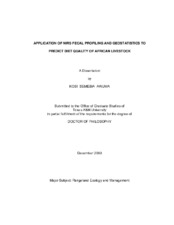| dc.description.abstract | Near infrared reflectance spectroscopy (NIRS) and geostatistical techniques were used to predict diet quality of sub-Saharan African (SSA) livestock, and to create cokriged estimated diet quality maps for cattle across a landscape. Rations of native vegetation were stall-fed to cattle (Bos indicus), sheep (Ovis aries), and goats (Capra hircus) to generate diet-fecal pair data. Trials were conducted in Ethiopia, Kenya, Uganda, Tanzania, and Ghana. Historical data from Ethiopia, Nigeria, and Niger were included. Diet samples were analyzed for crude protein (CP%), and digestible organic matter (DOM%), while feces were scanned for NIR spectra. NIRS equations were developed from data using modified partial least square (MPLS) regression. Coefficients of determination (R2) of CP for cattle, sheep, and goats were 0.92, 0.95, and 0.97, with corresponding standard errors of calibration (SEC) being 0.90, 0.79, and 0.80, respectively. Standard errors of cross validation (SECV) for CP were 1.12%, 1.08%, and 1.03% for cattle, sheep, and goats, respectively. R2 and SEC values for DOM were 0.88, 0.94, 0.94 and 2.82%, 1.68%, and 2.65%, for cattle, sheep, and goats, respectively. Corresponding SECV values for DOM were 3.26%, 2.07%, and 3.30%, respectively. The statistics reported were within the acceptable limits for NIRS calibrations. The results indicate that dietary CP and DOM of free-ranging SSA livestock can be predicted with the same precision as that of conventional wet chemistry methods. The cattle equation was used to predict cattle fecal samples collected, from February to August 2000, from selected households located within the northern Ghana savanna. The predicted CP% and DOM% were used with Normalized Differential Vegetation Index (NDVI) data, and cokriging technique to create diet quality maps for March and July 2000 for the northern Ghana savanna. Cross validation results indicated a moderate capability of cokriging to estimate predicted CP% for March (r2 = 0.687, SEp = 1.736) and July (r2 = 0.513, SEp = 1.558). Cokriged-estimated DOM value for July was above average (r2 = 0.584, SEp = 3.611), while March DOM% estimation was rather poor (r2 = 0.132, SEp = 3.891). The techniques of cokriging and creation of diet quality maps were moderately successful in this study. | en |


